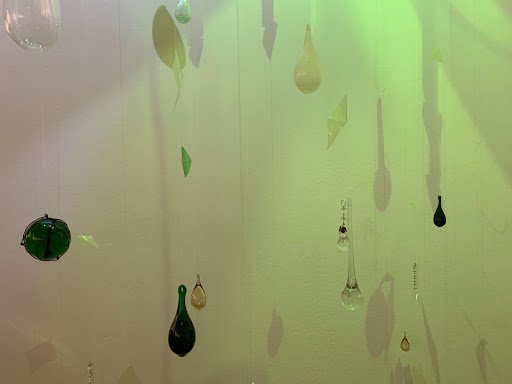Published in Newcity (online).
The first thing I discover about the special exhibitions booths at EXPO is that few of the workers attending them know what makes them “special exhibitions.” Some of the speculative answers I got included: “we don’t usually show art”; “their art is for sale, ours is not”; “we’re giving the audience ‘something else’”; and, my personal favorite, “they bought booths, we were given a special deal by a festival trying to fill up a pandemic-era EXPO”.
The official EXPO distinction is that these are non-profit institutions, museums, and organizations in the art world. They are, both figuratively and literally, the booths that make up the periphery. Here are a few that stood out, and why.
Part of “Inequity for Sale” by Tonika Lewis Johnson on display at Weinberg/Newton Gallery booth.
Weinberg/Newton (435)
Walking up to the Weinberg/Newton booth is walking up to the front door of 7250 S. Green St. An image of the home features prominently in the gallery’s wide booth. The home is boarded up, and its snow covered yard is notably neglected. A sign informs the booth’s visitors that the home was “legally stolen” from a Black resident in 1962. “Well they do that everyday, that’s all they do — steal land,” a passerby announces to no one as she reads the sign. Weinberg/Newton is a non-commercial gallery that exhibits projects that address and tackle social justice issues. The photo in the booth’s display is by Tonika Lewis Johnson, one of the three artists in exhibit. The display is an excerpt from Johnson’s “Inequity for Sale” exhibit, a work that digitally identifies and physically marks homes in Englewood that were sold to Black homeowners under shady Land Sale Contracts. The impact of this booth has little to do with this booth — it’s an exhibit that, for many Chicagoans, hits close to home. Other works included by Isabel Strauss (“On Collage”) and Riff Studio (“Architecture of Reparations”).
Photos by Marzena Abrahamik, on display at CPS Lives booth.
CPS Lives (146)
CPS Lives is an art residency program that places artists in Chicago Public Schools. That fact alone makes this booth exceptional, but the art it contains makes it stand out even more. Marzena Abrahamik, a photographer and educator, created portraits of students at the school she worked with and overlaid them on vivid shots of school day details. The photos are arresting — a surreal saturation blends with the everyday scenes. Norman Teague, the other artist exhibited, is a designer and educator. For his residency, he worked collaboratively with students on furniture pieces, and then incorporated his experiences with them into his own design work.
Crystals hanging from Dana Major’s growing installation at the 6018 North booth.
6018 North (455)
6018 North is an experimental gallery based in a dilapidated mansion in Edgewater. Their
green and white booth with the word “sustainability” scrawled across its front wall stood out as the most interactive booth at the fair. At a small stand facing the aisle, a young man greets me and asks me to write what I’d be willing to give up in order to create a more sustainable future. I cheat and write “meat” (I’m already vegetarian). He tells me a lot of people write that. The gallery’s owner, Tricia Van Eck, appears from around the corner and with a crystal (recycled from a chandelier store that was going out of business). Everyone who contributes their input gets to hang a crystal on a growing light installation by Dana Major. The crystal itself became tangled in a fishing line as we hang it — speaking to the mess we're in, and the collaboration necessary to get out of it, Tricia tells me. I can’t tell if that’s part of the piece or if she’s just really good on her toes.
Also worth your time:
Artadia (136) provides grants to mid-career artists in seven cities. The work on display was from last year’s Chicago grant recipients, and was some of my favorite in the EXPO. But I’m mostly shouting it out because I love seeing artists get paid.
Aperture (130), because of its legacy. And because of their book table. Who, at an event like this, doesn’t love a good coffee table book?
Center for Native Futures (421), a non-profit organization founded during the pandemic to “make space for a perpetual Native presence in the city of Zhegagoynak (Chicago).” The wide booth presented, coherently, the work of eight separate artists, while managing to give them all room to breath.
Daata (417), an online gallery (“Zoom is our headquarters,” the booth attendant told me) which was the only booth to utter “NFT.”
Museum of Science and Industry (449), for having one art exhibition per year, for the past fifty years.


